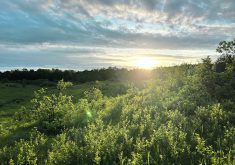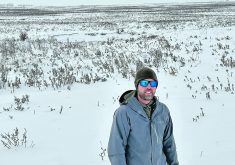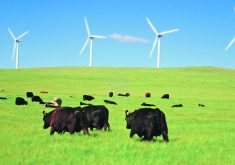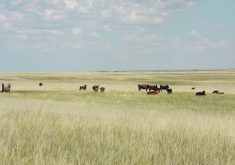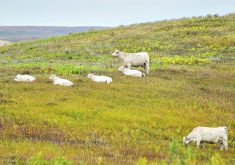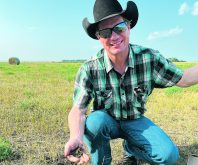The Nature Conservancy of Canada’s Cave Pasture is adjacent to Swift Current, Sask., which provides easy access
SWIFT CURRENT, Sask. — It’s almost unbelievable that a large piece of native grassland lies exactly north of Swift Current’s city boundary.
Much of the province’s native grass has been lost over time, but anyone driving in and out of the city on Highway 4 passes by the 707 acre pasture on the west side of the road. It’s not far from development such as the city’s hospital, retail areas and housing.
It’s home to numerous species, including sharp-tailed grouse, and provides habitat for some listed under the federal Species at Risk Act, such as loggerhead shrike, Sprague’s pipit, lesser yellowlegs and long-billed curlew.
Read Also

Canadian Food Inspection Agency slammed for handling of bovine tuberculosis case
The federal government leans heavily on producers to “take one for the team” and risk their livelihoods without any reassurance of support.
During a recent pasture tour, cattle grazed on the hillside.
Nature Conservancy of Canada bought the pasture in 2023 from the Cave family somewhat unexpectedly.
Michael Burak, NCC program director for southwestern Saskatchewan, said the realtor who had the listing brought it to the organization’s attention. That happens occasionally, Burak said, including on a previous project near Buffalo Pound Lake near Moose Jaw.
“The pasture listing was pretty intriguing right off the bat for a couple different reasons, one being just how close to the city of Swift Current it was and that it was completely unbroken native prairie,” he said.
That proximity and the east-side highway frontage pushed the price point higher than if the land was in a more remote location. Fortunately for Saskatchewan, some projects in other parts of Canada didn’t go ahead, making money available for the purchase.
Burak said the land has long been used for grazing, and that will continue.
Aside from bordering the highway, there are a couple of power lines on the property.
NCC wasn’t sure what it would find when it finally got out on the land to assess it.
It was spring and in low lying areas the water had attracted a large diversity of waterfowl and shorebird species.
“One of the things that we really were pleased to see, even just from kind of the roadside type inspection that we had done before the purchase, was the grassland was actually in really good shape,” he said.
“It was really well looked after, well stewarded, prior to us taking ownership of it.”
The land was rested in 2023, not because of grass condition but because there was no water for the cattle.
“It takes a lot of water pretty early on in the year, and there’s a couple spots that tend to hold onto it longer than others, but there wasn’t really a good solid kind of water source for cattle in the long term,” Burak said.
Last fall NCC developed a dugout on the west side and a spring and deep area for water to pool in cells in the southwestern corner.
Two reliable water sources make the pasture even more suitable for grazing. Burak said the lessees are happy with the improvements.
“We told them to just kind of keep doing what they have been doing previously as it seems to be working,” he said.
During the June tour, a group of about 50 interested people ventured across the pasture to establish a ferruginous hawk platform and put up birdhouses.

The Cave pasture is open to public foot traffic. Being so close to the city means NCC might be more vigilant in terms of preventing ATVs and snowmobiles from entering, but Burak said neither the Cave family nor the lessees noted any major concerns over the years.
“We’re hoping that it won’t really mean a tonne of change,” he said.
The proximity to the city does provide opportunities for NCC to do more outreach, such as the platform building and developing community relationships.
“We’re not a super well-known household name in a lot of areas, especially the Swift Current area, where we didn’t really have a tonne of supporters on record in any of our databases yet,” Burak added.
“We’re hoping now that we’ve got a bit of a foothold in terms of land and people can get out there and explore and appreciate the work that we’re doing, that we may see some growth in support in that area.”
Another hawk platform will be going up on the pasture, but it will be in a more difficult location to access so will be done by staff.
The bird houses along the fence line will need annual maintenance and cleaning, which could be a volunteer event.
There is public access and room to park along the west side of the pasture.
“Just leave any gates the way that you find them and make sure that you’re giving cattle a safe space to graze without being bothered,” he said.




